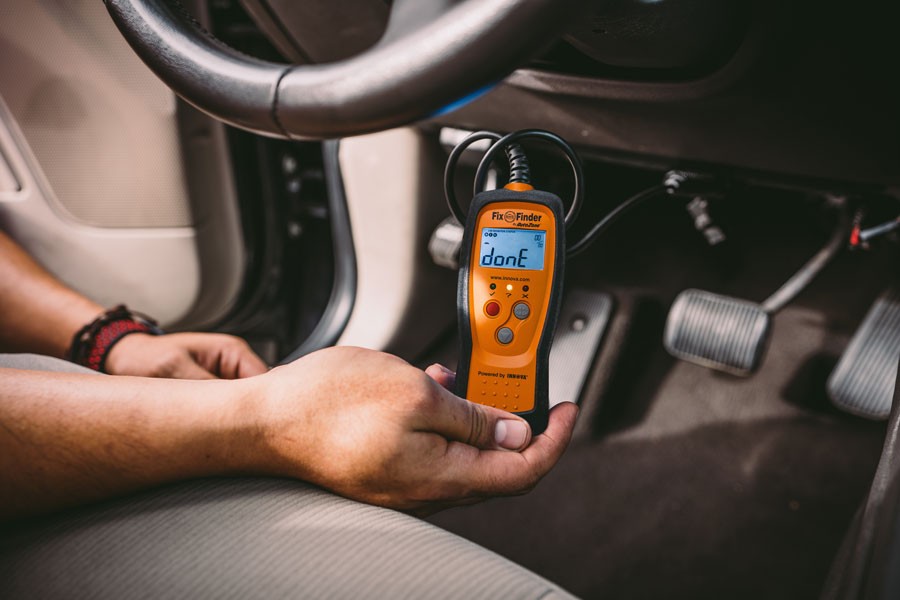Connecting a car auto scanner, also known as an OBD2 scanner, can seem daunting. However, with a little guidance, anyone can learn how to use this valuable tool to diagnose car problems. This guide will walk you through the process, from locating the OBD2 port to understanding the codes.
Locating and Connecting the OBD2 Port
The OBD2 port in most vehicles is a 16-pin trapezoidal connector located under the driver’s side dashboard. Sometimes, it might be hidden in the center console or under the passenger side dash.
Connecting your car auto scanner is straightforward. Align the trapezoidal connector of the scanner with the port and firmly push them together. A slight wiggle might be needed for a secure connection.
Here’s the recommended connection procedure:
- Ignition Off: Ensure your car’s ignition is switched off.
- Connect Scanner: Plug the scanner into the OBD2 port.
- Ignition On: Turn the ignition to the “on” position without starting the engine. This powers the scanner.
- Boot Sequence: Allow the scanner to complete its boot-up sequence.
Your scanner may prompt you for additional information, such as the vehicle’s VIN or engine size.
Navigating the Scanner Menu
Once booted, your car auto scanner will display a menu. Options vary depending on the scanner type, ranging from basic code readers to advanced diagnostic tools. Common menu options include:
- Read Codes: Displays Diagnostic Trouble Codes (DTCs), often with a brief description of the fault.
- Erase Codes: Clears stored DTCs from the vehicle’s computer memory. Always confirm before erasing.
- Live Data: Shows real-time sensor readings, allowing you to monitor various parameters. This helps identify sensors operating outside normal ranges.
- Freeze Frame: Captures vehicle data at the moment a DTC was set, providing valuable diagnostic context. This snapshot helps pinpoint the conditions triggering the fault.
- Vehicle Info: Displays vehicle-specific data, like the VIN and engine type.
- I/M Readiness: Indicates the status of emissions-related systems for smog testing.
Understanding Diagnostic Trouble Codes (DTCs)
When you select “Read Codes,” the scanner displays DTCs in a specific format: a letter followed by four numbers (e.g., P0301).
-
The letter signifies the system:
- P: Powertrain (engine, transmission, emissions)
- B: Body (airbags, interior systems)
- C: Chassis (suspension, steering)
- U: Network communication
-
The first number indicates the code type:
- 0: Generic (applicable to most manufacturers)
- 1: Manufacturer-specific
-
The remaining three numbers pinpoint the specific fault within the system. For example, in P0301:
- The second digit (0) signifies a generic code.
- The third digit (3) points to the ignition system or a misfire.
- The fourth digit (1) specifies cylinder number 1. Therefore, P0301 indicates a misfire in cylinder 1.
Using a Car Auto Scanner to Save on Repairs
A car auto scanner empowers you to diagnose car problems, potentially saving money on repairs. By identifying the source of a Check Engine Light or performance issue, you can:
- Determine if a DIY fix is feasible.
- Assess readiness for emissions testing.
- Potentially save on diagnostic fees at a repair shop. For example, code P0138 indicates a faulty oxygen sensor, a common DIY repair.
Conclusion
Mastering how to use a car auto scanner is a valuable skill for any car owner. It allows for quicker diagnosis of car problems, potentially saving time and money on repairs. While a scanner doesn’t provide a complete solution, it’s an essential first step in troubleshooting. Understanding the codes and utilizing the scanner’s features can empower you to make informed decisions about your vehicle’s maintenance.

